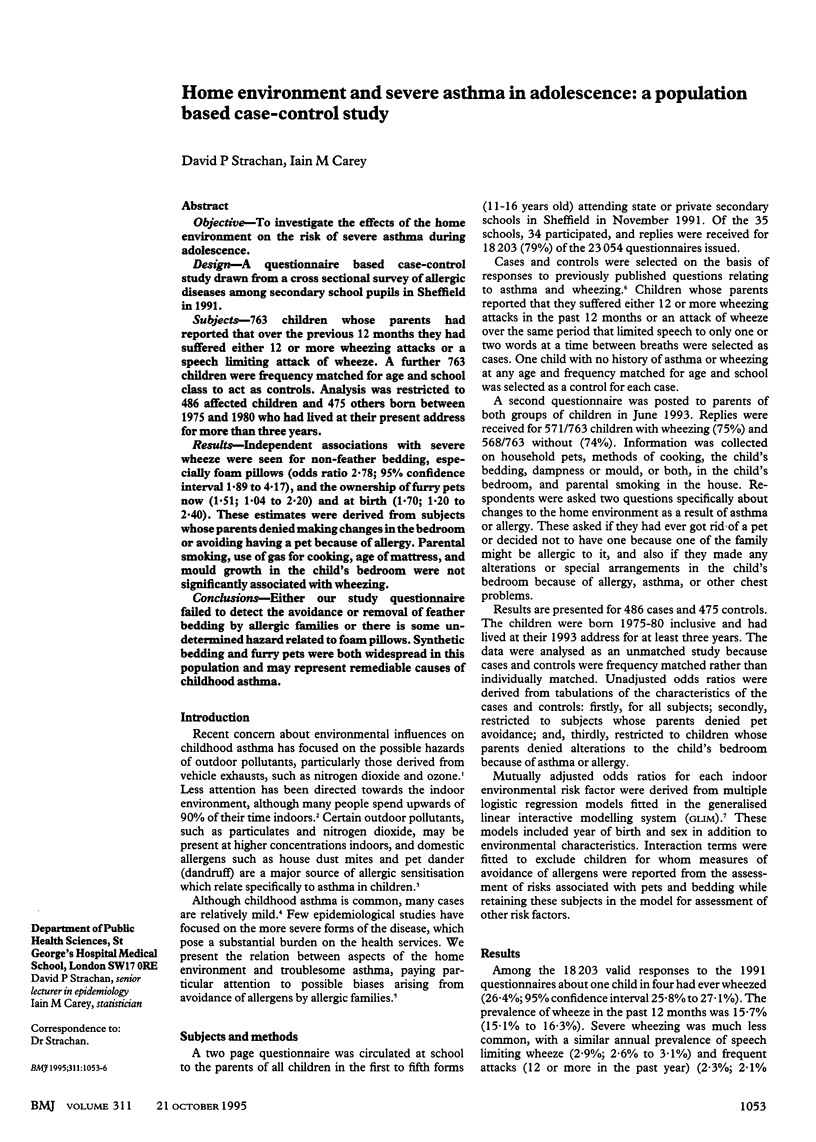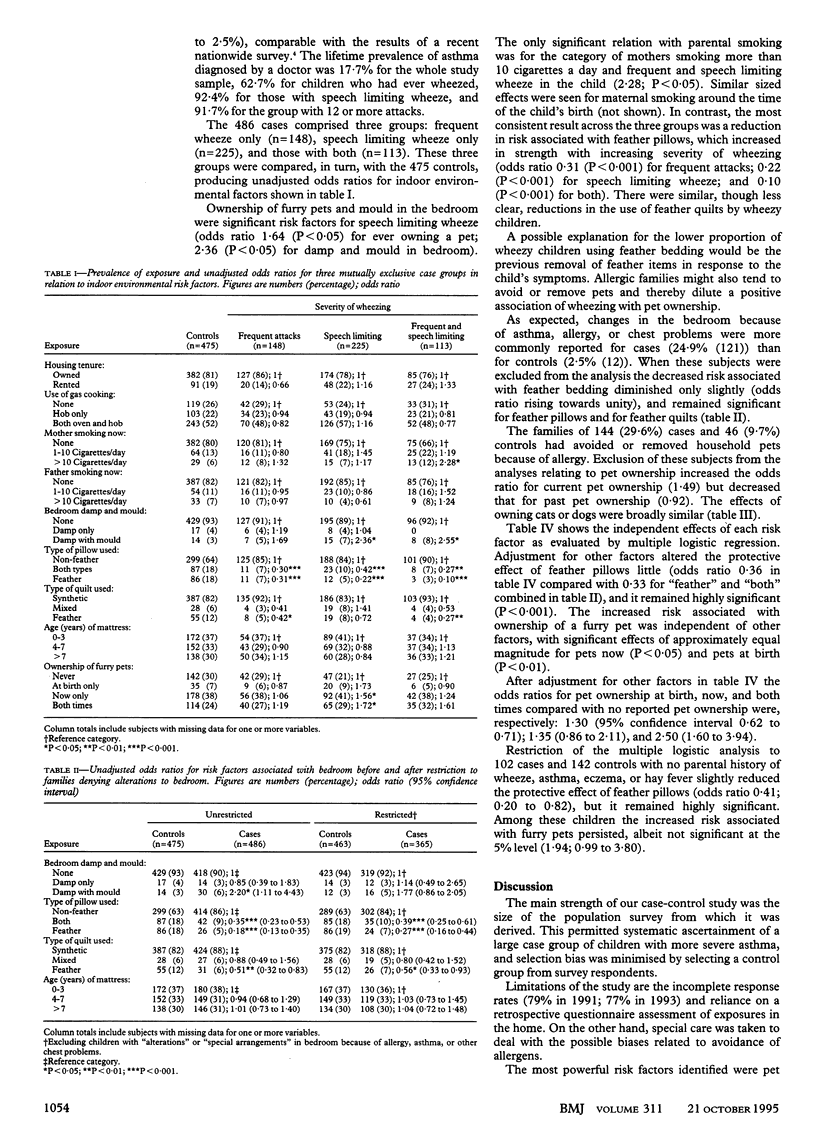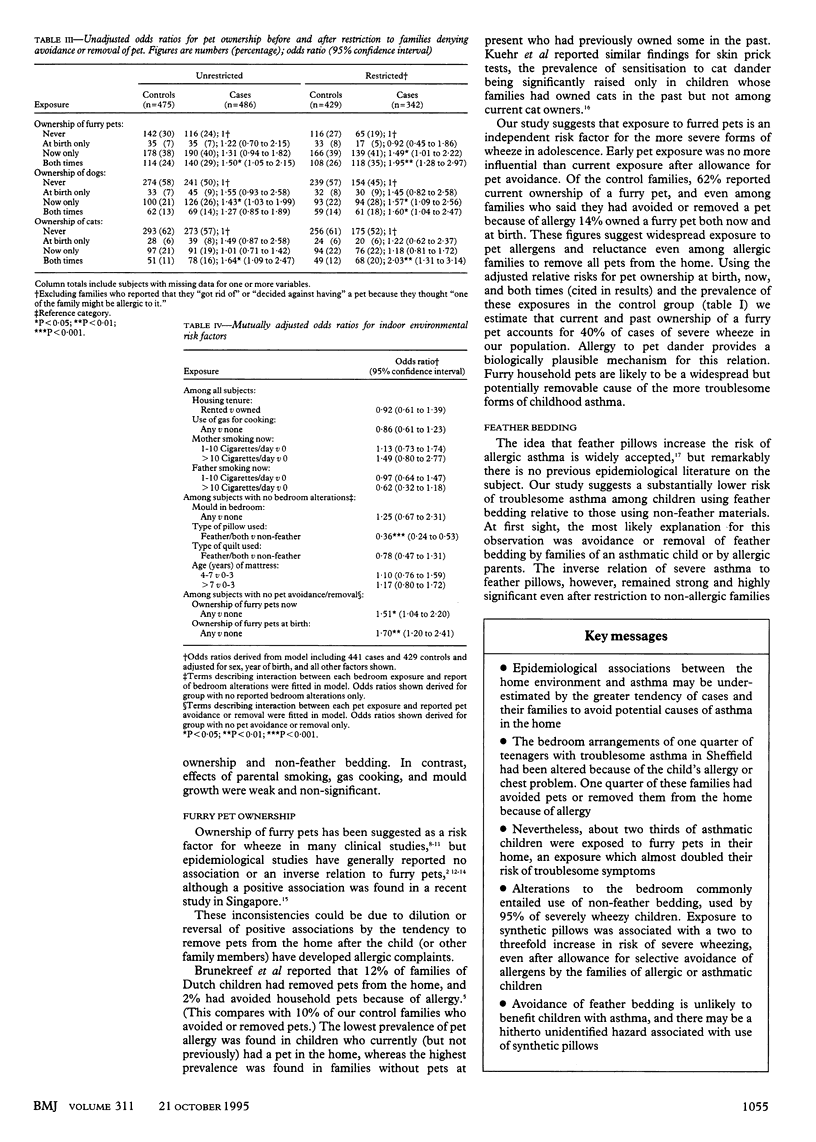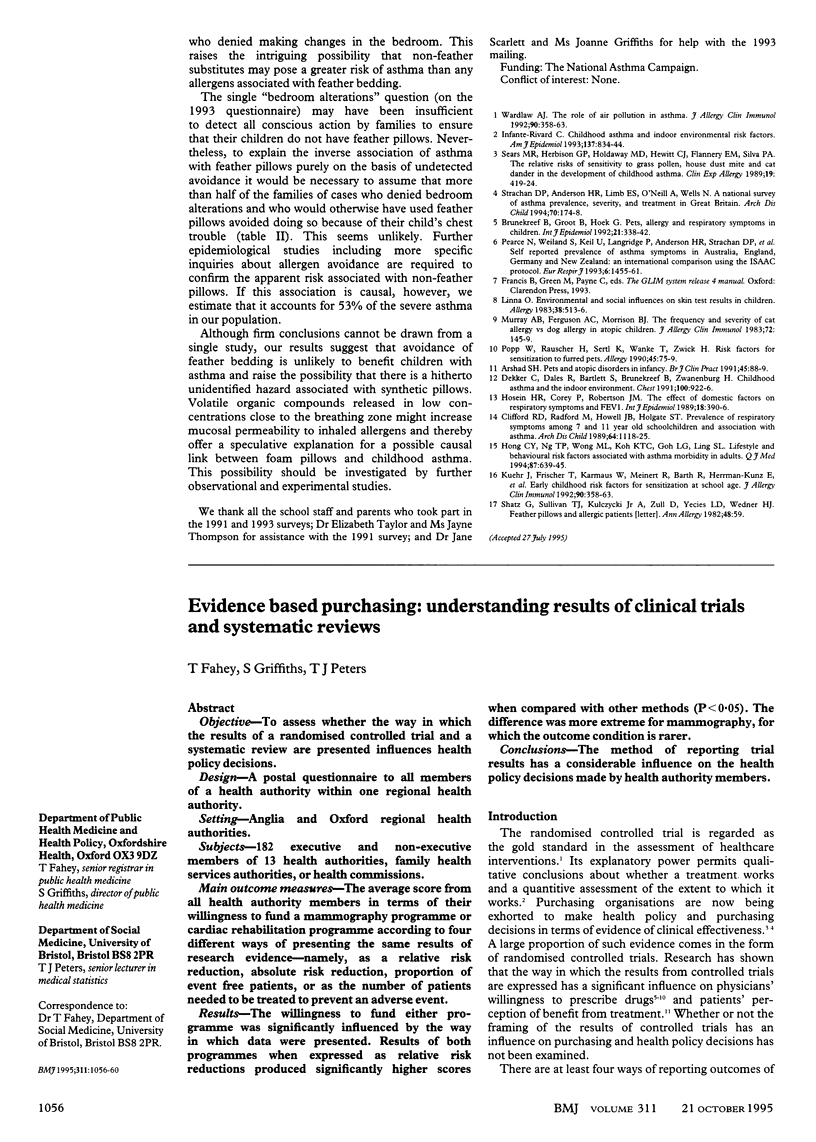Abstract
OBJECTIVE--To investigate the effects of the home environment on the risk of severe asthma during adolescence. DESIGN--A questionnaire based case-control study drawn from a cross sectional survey of allergic diseases among secondary school pupils in Sheffield in 1991. SUBJECTS--763 children whose parents had reported that over the previous 12 months they had suffered either 12 or more wheezing attacks or a speech limiting attack of wheeze. A further 763 children were frequency matched for age and school class to act as controls. Analysis was restricted to 486 affected children and 475 others born between 1975 and 1980 who had lived at their present address for more than three years. RESULTS--Independent associations with severe wheeze were seen for non-feather bedding, especially foam pillows (odds ratio 2.78; 95% confidence interval 1.89 to 4.17), and the ownership of furry pets now (1.51; 1.04 to 2.20) and at birth (1.70; 1.20 to 2.40). These estimates were derived from subjects whose parents denied making changes in the bedroom or avoiding having a pet because of allergy. Parental smoking, use of gas for cooking, age of mattress, and mould growth in the child's bedroom were not significantly associated with wheezing. CONCLUSIONS--Either our study questionnaire failed to detect the avoidance or removal of feather bedding by allergic families or there is some undetermined hazard related to foam pillows. Synthetic bedding and furry pets were both widespread in this population and may represent remediable causes of childhood asthma.
Full text
PDF



Selected References
These references are in PubMed. This may not be the complete list of references from this article.
- Arshad S. H. Pets and atopic disorders in infancy. Br J Clin Pract. 1991 Summer;45(2):88–89. [PubMed] [Google Scholar]
- Brunekreef B., Groot B., Hoek G. Pets, allergy and respiratory symptoms in children. Int J Epidemiol. 1992 Apr;21(2):338–342. doi: 10.1093/ije/21.2.338. [DOI] [PubMed] [Google Scholar]
- Clifford R. D., Radford M., Howell J. B., Holgate S. T. Prevalence of respiratory symptoms among 7 and 11 year old schoolchildren and association with asthma. Arch Dis Child. 1989 Aug;64(8):1118–1125. doi: 10.1136/adc.64.8.1118. [DOI] [PMC free article] [PubMed] [Google Scholar]
- Dekker C., Dales R., Bartlett S., Brunekreef B., Zwanenburg H. Childhood asthma and the indoor environment. Chest. 1991 Oct;100(4):922–926. doi: 10.1378/chest.100.4.922. [DOI] [PubMed] [Google Scholar]
- Hong C. Y., Ng T. P., Wong M. L., Koh K. T., Goh L. G., Ling S. L. Lifestyle and behavioural risk factors associated with asthma morbidity in adults. QJM. 1994 Oct;87(10):639–645. [PubMed] [Google Scholar]
- Hosein H. R., Corey P., Robertson J. M. The effect of domestic factors on respiratory symptoms and FEV1. Int J Epidemiol. 1989 Jun;18(2):390–396. doi: 10.1093/ije/18.2.390. [DOI] [PubMed] [Google Scholar]
- Infante-Rivard C. Childhood asthma and indoor environmental risk factors. Am J Epidemiol. 1993 Apr 15;137(8):834–844. doi: 10.1093/oxfordjournals.aje.a116745. [DOI] [PubMed] [Google Scholar]
- Kuehr J., Frischer T., Karmaus W., Meinert R., Barth R., Herrmann-Kunz E., Forster J., Urbanek R. Early childhood risk factors for sensitization at school age. J Allergy Clin Immunol. 1992 Sep;90(3 Pt 1):358–363. doi: 10.1016/s0091-6749(05)80015-6. [DOI] [PubMed] [Google Scholar]
- Kuehr J., Frischer T., Karmaus W., Meinert R., Barth R., Herrmann-Kunz E., Forster J., Urbanek R. Early childhood risk factors for sensitization at school age. J Allergy Clin Immunol. 1992 Sep;90(3 Pt 1):358–363. doi: 10.1016/s0091-6749(05)80015-6. [DOI] [PubMed] [Google Scholar]
- Linna O. Environmental and social influences on skin test results in children. Allergy. 1983 Oct;38(7):513–516. doi: 10.1111/j.1398-9995.1983.tb02360.x. [DOI] [PubMed] [Google Scholar]
- Murray A. B., Ferguson A. C., Morrison B. J. The frequency and severity of cat allergy vs. dog allergy in atopic children. J Allergy Clin Immunol. 1983 Aug;72(2):145–149. doi: 10.1016/0091-6749(83)90522-5. [DOI] [PubMed] [Google Scholar]
- Pearce N., Weiland S., Keil U., Langridge P., Anderson H. R., Strachan D., Bauman A., Young L., Gluyas P., Ruffin D. Self-reported prevalence of asthma symptoms in children in Australia, England, Germany and New Zealand: an international comparison using the ISAAC protocol. Eur Respir J. 1993 Nov;6(10):1455–1461. [PubMed] [Google Scholar]
- Popp W., Rauscher H., Sertl K., Wanke T., Zwick H. Risk factors for sensitization to furred pets. Allergy. 1990 Jan;45(1):75–79. doi: 10.1111/j.1398-9995.1990.tb01087.x. [DOI] [PubMed] [Google Scholar]
- Sears M. R., Herbison G. P., Holdaway M. D., Hewitt C. J., Flannery E. M., Silva P. A. The relative risks of sensitivity to grass pollen, house dust mite and cat dander in the development of childhood asthma. Clin Exp Allergy. 1989 Jul;19(4):419–424. doi: 10.1111/j.1365-2222.1989.tb02408.x. [DOI] [PubMed] [Google Scholar]
- Shatz G., Sullivan T. J., Kulczycki A., Jr, Zull D., Yecies L. D., Wedner H. J. Feather pillows and allergic patients. Ann Allergy. 1982 Jan;48(1):59–59. [PubMed] [Google Scholar]
- Strachan D. P., Anderson H. R., Limb E. S., O'Neill A., Wells N. A national survey of asthma prevalence, severity, and treatment in Great Britain. Arch Dis Child. 1994 Mar;70(3):174–178. doi: 10.1136/adc.70.3.174. [DOI] [PMC free article] [PubMed] [Google Scholar]


